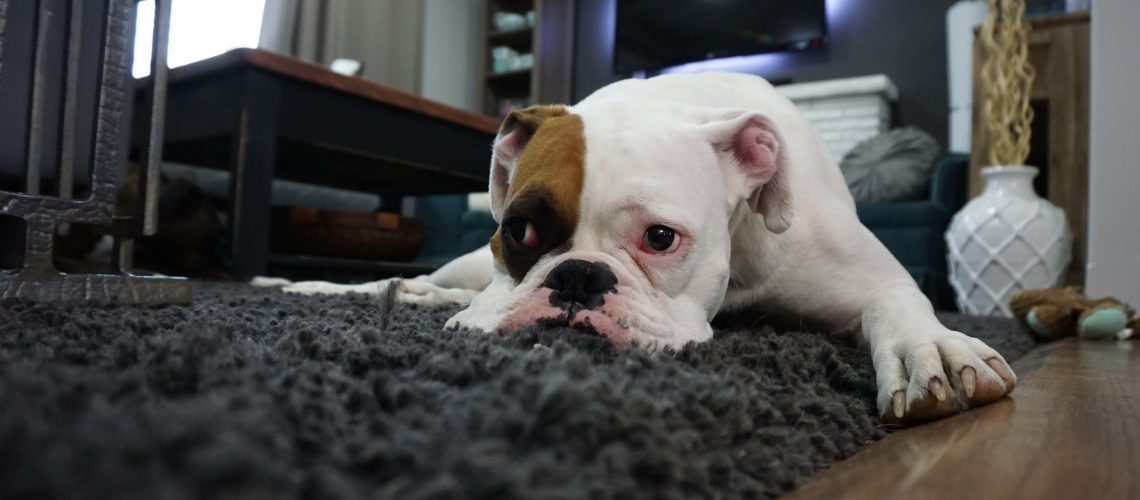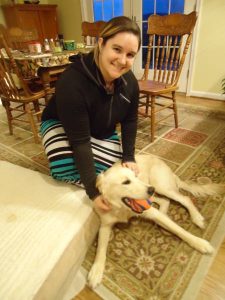[The names of individuals in this case study were changed to ensure privacy.]
Introduction
This case study was conducted as a training regiment for one of my clients, a 6-month-old Golden Retriever puppy named Carly. Most of my behavioral training contracts last upwards of four sessions. In Carly’s case, the techniques used achieved such immediate results, we only needed one session to help her. I wanted to share a thorough explanation of the circumstances in this case study.
Dog History
Carly was a beautiful 6-month-old pale white Golden Retriever. Her owner, Laura, had recently adopted Carly from her previous owner. There was not much to tell about Carly. Her previous owners – possibly her breeders – had little to say of her. She was a bouncy, cuddly puppy as Goldens typically are.
Emergence of Behavior
Carly had never been on a leash, and was confused by the experience. When on leash, Carly would shut down, not wanting to move. She also demonstrated a lot of anxiety around hard floors and would refuse to walk on them.
Laura planned to move into a new house within the month. While moving, Laura’s parents offered to keep Carly at their home. It was evident that the previous owner’s comments about flooring were true, as the parents’ home was almost completely hardwood flooring with some throw rugs from room to room. Carly would dart from rug to rug, or stay for hours in her dog bed in the kitchen. Her lack of experience on the leash also showed during walks, where she would shut down mid-walk, sitting down and refusing to move while also exhibiting anxious symptoms such as shaking or heavy panting. The parents resorted to carrying her home in these situations.
Finally, some unexpected behavior began to develop early on. The path the parents took through the house to take Carly outside went through the hard floored kitchen and garage. As a result, Carly started to exhibit fear toward the garage and to vehicles, both in and outside of the garage.
Evaluation and Approach
When Laura contacted me, it was a fairly simple discussion over the phone. Carly lacked the confidence she needed to deal with a new environment and experiences. Meeting Carly for her first training session reaffirmed these deductions and we got to work.
Developing confidence in an anxious dog can happen a few ways. The most natural response for most people is to console the dog and try to reward it for tolerating what is making them anxious. This, unfortunately, typically leads to worse behavior over time.
When a friend or family member is crying, we hug them and console them with meaningful words. But dogs do not understand these concepts. They cannot grasp consolation, and instead see touching and talking in this manner to be a reward for behaving a certain way. This reinforces their anxious behavior, making them think that behavior is how we want them to behave. It is always important when working with any dog to understand their thought process and do our best to avoid communicating to them in a way which sends mixed signals such as this.
In Carly’s case, Laura and her parents had started down this road, unaware they had only escalated Carly’s behavior. The first step then was to explain this and give them a different approach to Carly’s anxiety. Because Carly was also not familiar with the leash, I chose to use it as a positive tool for overcoming her anxiety toward the floor, which could then migrate to every other object or environment where she felt uneasy. Here’s how we progressed.
- I started by simply hooking Carly to the leash while she was in her bed in a calm state. Once leashed, I calmly gave tension to the leash, just enough to encourage Carly to take a step forward. If she gave me a step, the tension disappeared. Multiple steps earned no tension and calm, positive verbal markers. If she gave more steps than I expected of her, she would receive a food treat to emphasize the positivity of her actions.
- It is crucial at this stage not to over-excite the dog. Excited energy in a dog can easily switch from positive behavior to negative, which includes over excitement, heightened anxiety, and even aggression depending on the dog. I didn’t want Carly to get so excited that she would be overcome by the anxiety triggers around her and shut down.
- In the same way we don’t want to over-excite an anxious dog, we also don’t want to reward anxious behavior. If Carly moved backward, I made sure not to acknowledge the behavior. Once she made forward progress, she would receive that vocal acknowledgement, rewarding her forward movement.
- Also note that this preliminary step does not involve the hardwood floor. This first step happened completely on a throw rug kept beneath her bed. Having Carly develop confidence in the leash also develops her confidence in me, making it easier for her to trust me in more difficult, anxious situations such as the floor. Combining too many situations at once would also increase her anxiety, leading to a shut down.
- After 5-10 minutes building her confidence in me and the leash, I began talking Carly to the edge of the throw rug and onto the hardwood floor. At first, the edge of the floor was met with resistance. However, because of the previous exercise, Carly had learned that when tension occurs in the leash, I want her to reduce that tension by moving forward. She understood that moving forward not only makes me happy, but also makes herself more comfortable.
We repeated the same process, create tension in the leash, reward for forward movement. Eventually (about 15 minutes), Carly had all four paws on the hardwood floor, smoothly walking onto the floor.- Note: During this step, we used treats minimally. The only time a treat was offered was after all four paws were on the hardwood floor. This is again to reduce the amount of excitement during the exercise.
- With Carly now on the hardwood floor, we spent some time just being there. I kept the leash loose, but did not give Carly enough leash to retreat back to the rug. The only goal for this step was to have her accept being on the floor completely and trust my judgment to have her there. It only took about two minutes before she was no longer resisting being on the floor, which I rewarded with a treat.
- Now that Carly could stand on the hard floor without protest, I wanted to make being on the floor a positive experience. I also wanted to break her concentration from the floor. Although she was standing on the floor without resistance, she was having trouble relaxing. I wanted to encourage her to enjoy herself on and off the rug until there was no difference between the two in her mind.
As a retriever, she loved tennis balls and playing fetch. So I held a tennis ball and began lightly rolling it in front of Carly. As she gave it more attention, I began lightly bouncing it and vocally praising her for coming closer to it and giving it more attention. Once she was interacting with it, I rolled it away from both of us and farther onto the floor. Although hesitant, she did move forward and retrieved the ball, bringing it back to me. We continued this gradually, until I was bouncing the ball along the floor, over another rug in the room, and having her go after it. - Finally, I took the ball and walked Carly around the entire first floor, from rug to hardwood and back. Removing the positive stimulation allowed Carly to be distracted by the hard floor again. However, because of the confidence built during the exercise, a small amount of tension was enough to drive her forward.
The kitchen still met with more resistance, primarily if I tried to lead her toward the garage door. This was another point of anxiety which we didn’t address during the session. We accepted the victory of the floor and ended the session there.
I left the owners with this progress and encouraged them to lead Carly with confidence around things she was hesitant around. Their homework was 15-30 minutes, multiple times a day to work on areas she was still having problems with.
Final Results

After our first session, Laura and her parents followed my advice and continued to lead and challenge Carly every day. They used the walk, scary objects like vehicles and the vacuum, and everyday life to practice. The evening before our scheduled second session, I received a call from Laura. The approach worked so well, that in the week between sessions, she was exhibiting no more signs of anxiety. She was walking well on the leash outside without tension or pulling. She would willingly move around the house, walking on both rugs and hardwood floor without hesitation. They could call her to the garage and walk her along the cars without worry.
We decided no more sessions were necessary for Carly and she continues to this day to be a happy dog with no anxieties at all.
Take-Aways
- Dogs do not understand comforting behavior like humans do. They can perceive things like soothing words and calm petting as reward for their actions. For most anxiety cases, vocal, physical, and edible rewards should be used sparingly and at the right moments. Those moments being when they are overcoming their anxious behavior and behaving in a more healthy manner.
- Anxiety can be amplified by over excitement. When working with an anxious case, a calm approach is necessary to avoid regression back into anxious behaviors. As the dog shows more confidence, more excitement can be introduced.
- Anxious dogs lack confidence. The more you can display calm, confident leadership for your dog, the more they will feed off that feeling and display confidence of their own.
If you are experiencing anxious behavior with your dog or any other behavioral issue, please email me at virginia@ghdogs.com or text me at 717-814-8527 to request an in-house or online consultation to start developing your dog’s winning training plan.


